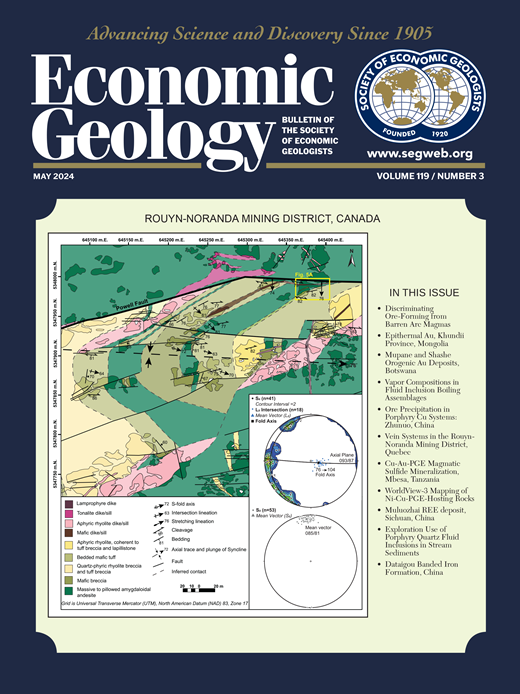阐明碳氢化合物在朱砂(HgS)成矿中的作用:德克萨斯州大本德国家公园Terlingua矿区汞成矿的一个模型
IF 4.9
1区 地球科学
Q1 GEOCHEMISTRY & GEOPHYSICS
引用次数: 0
摘要
富有机质烃源岩与汞矿床的成因关系一直是争论的焦点。本文评价了美国德克萨斯州Terlingua矿区的富有机质烃源岩在与侵入碱火成岩相关的白垩系沉积岩中相对较浅的沉积层中的作用。矿化形成于~45 bar和~200℃。含水成矿流体pH值为~5 ~ 7,硫化氢饱和。朱砂是由H2S与当地大气水混合冷却氧化而成。Hg0(org)和Hg0(aq)在朱砂成矿过程中可能都很重要。然而,最近对Hg0在烃类中的溶解度的研究表明,在朱砂饱和时,Hg0在烃类中的溶解度(Hg0(org) = 163 mg/kg)比Hg0在水中的溶解度(Hg0(aq) = 10.8 mg/kg)高一个数量级以上。尽管它们在某些矿床中接近,但稀有的氯化汞和硫酸盐矿物的成矿条件与大多数朱砂矿石的形成条件不相容,需要fO2条件的氧化性强几个数量级,氯离子活性相对较高(10-1),碱性条件,pH值>10. Terlingua含汞矿物中Hg同位素数据的质量依赖分选与质量不依赖分选支持了汞来源的遗传联系,即下鹰滩组富有机质泥灰岩和凝灰质黑色页岩。该烃源岩在年代地层上与下白垩统海洋缺氧事件(OAE-2)相当,该事件确定了塞诺曼—turonian边界。OAE-2代表了~94.1 Ma全球缺氧海洋事件的高潮,被认为是与大型火成岩省相关的火山活动的结果。汞被富含有机物的下鹰滩组烃源岩以及与之相关的同时期灰岩和凝灰岩所隔离。侵入和抬升当地地层的板状火成岩形成了Terlingua单斜,为热液活动和有机质成熟提供了热源。下Eagle Ford组液态烃和地层盐水随后的生成和运移将Hg0(org)向Terlingua单斜的接合线上移,在那里与含氧大气水混合,随后H2S氧化产生了富朱砂矿石。本文章由计算机程序翻译,如有差异,请以英文原文为准。
Elucidating the Role of Hydrocarbons in Cinnabar (HgS) Ore Formation: A Model for Hg Mineralization in the Terlingua Mining District, Big Bend National Park, SW Texas
Abstract The genetic relationship between organic-rich source rocks and Hg deposits remains the subject of debate. This paper evaluates the role of organic-rich source rocks in cinnabar ore formation in the Terlingua mining district, Texas, which was deposited at relatively shallow depths in Cretaceous sedimentary rocks spatially related to intrusive alkali igneous rocks. The mineralization formed at ~45 bar and ~200°C. The aqueous ore-forming fluid had a pH of ~5 to 7 and was H2S saturated. Cinnabar was deposited as a result of H2S oxidation through mixing and cooling with local meteoric water. Both Hg0(org) and Hg0(aq) species were likely important in cinnabar ore formation. However, recent studies on the solubility of Hg0 in hydrocarbons show that at cinnabar saturation, Hg0 is more than an order of magnitude more soluble in hydrocarbons (Hg0(org) = 163 mg/kg) than Hg0 in water (Hg0(aq) = 10.8 mg/kg). Despite their proximity in some deposits, conditions of ore formation of the rare Hg oxychloride and sulfate minerals are not compatible with conditions under which most cinnabar ores formed, requiring fO2 conditions orders of magnitude more oxidizing, a relatively high chloride ion activity (>10–1), and alkaline conditions, with pH > 10. Mass dependent fractionation versus mass independent fractionation of Hg isotope data from Hg-bearing minerals in Terlingua support a genetic link to the source of Hg being the organic-rich marls and tuffaceous black shales of the Lower Eagle Ford Formation. This source rock is chronostratigraphically equivalent to the Lower Cretaceous oceanic anoxic event (OAE-2), which defines the Cenomanian-Turonian boundary. OAE-2 represents the culmination of a global anoxic ocean event at ~94.1 Ma, believed to be a consequence of volcanic activity associated with a large igneous province. Mercury was sequestered by the organic-rich source rocks of the Lower Eagle Ford Formation and associated coeval ash and tuffs. Tabular igneous bodies that intruded and uplifted the local stratigraphy formed the Terlingua monocline and provided a source of heat for hydrothermal activity and maturation of organic matter. The subsequent generation and migration of liquid hydrocarbons and formation brines from the Lower Eagle Ford Formation transported Hg0(org) updip toward the hinge line of the Terlingua monocline where mixing with oxygenated meteoric water and subsequent oxidation of H2S produced the cinnabar-rich ores.
求助全文
通过发布文献求助,成功后即可免费获取论文全文。
去求助
来源期刊

Economic Geology
地学-地球化学与地球物理
CiteScore
10.00
自引率
6.90%
发文量
120
审稿时长
6 months
期刊介绍:
The journal, now published semi-quarterly, was first published in 1905 by the Economic Geology Publishing Company (PUBCO), a not-for-profit company established for the purpose of publishing a periodical devoted to economic geology. On the founding of SEG in 1920, a cooperative arrangement between PUBCO and SEG made the journal the official organ of the Society, and PUBCO agreed to carry the Society''s name on the front cover under the heading "Bulletin of the Society of Economic Geologists". PUBCO and SEG continued to operate as cooperating but separate entities until 2001, when the Board of Directors of PUBCO and the Council of SEG, by unanimous consent, approved a formal agreement of merger. The former activities of the PUBCO Board of Directors are now carried out by a Publications Board, a new self-governing unit within SEG.
 求助内容:
求助内容: 应助结果提醒方式:
应助结果提醒方式:


